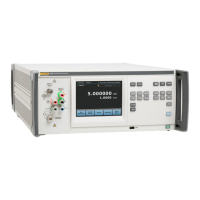Front Panel Operation
Techniques for Reducing Transfer Errors 4
4-33
Loading
The Product input impedance may affect ac voltage source output levels. See
Table 4-4 for the input impedance on each range. Sources with resistive dividers
on the output are especially sensitive to loading errors. Cables present an
additional capacitive load to the source.
Check the specifications and instruction manual for each type of ac voltage
source before connecting the source to the Product. Avoid exceeding the drive
capability of the ac voltage source, no matter what the transfer application is.
When in doubt, use an oscilloscope or spectrum analyzer to make sure the ac
source is not loaded to the point that it is producing a distorted signal.
Before you calibrate an ac voltage source, there is another source of loading
error to consider. What will the ac voltage source be used for after calibration?
Many meters have highly capacitive inputs and present a much heavier load than
the transfer standard. One way to compensate for meter loading is to simulate a
meter load during calibration with the Product. To simulate a meter load, connect
a load equivalent in capacitance and resistance of the meter input across the
Product input.
Mechanical Contact
Connection contact resistance variation is a potential error source on the ranges
above 2.2 V. By using high quality cables and connectors, you can minimize this
source of error. Use stainless steel coaxial connectors if possible. They are
machined with more precise threads, which make better electrical contact. The
Type "N" connectors on the Product are all stainless steel.
To achieve the highest quality measurements, do not disturb the instrumentation
setup during the course of a transfer. Try not to move, jostle, or vibrate the
Product, the source, or any of the input signal wiring from the time you apply the
first input voltage until you take the last reading of the transfer.
Note
Most importantly, always repeat the measurements until you are
satisfied that the results are repeatable relative to the specification
being measured.
Thermal EMFs
Avoid thermal emf errors in the cabling between a dc voltage source and the
INPUT 2 binding posts. Thermal emfs introduce bias into the dc voltage as seen
by the Product. To reduce thermal emf errors, use low thermal emf cables and
connectors and avoid touching any connection during a transfer. All it takes to
change the emf error and adversely affect a transfer is to briefly touch a
connector or binding post. It typically takes five minutes to thermally stabilize a
connection after it has been touched.

